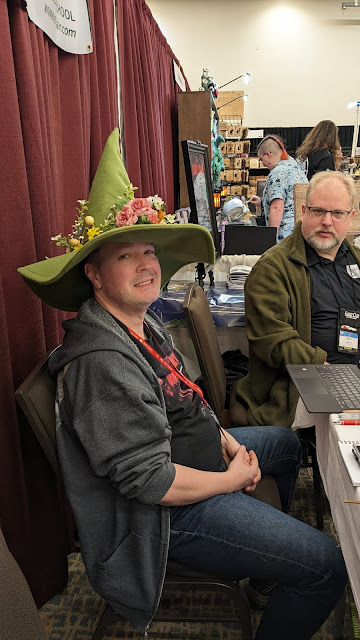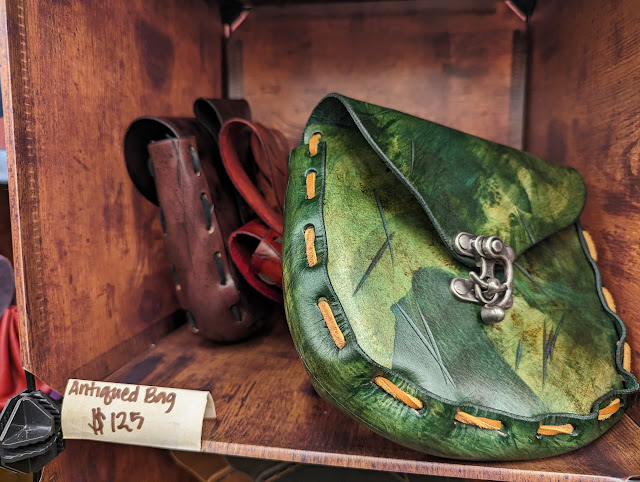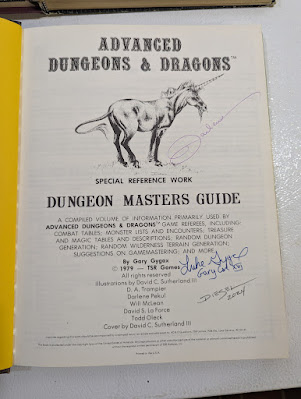Welcome to the A to Z blogging challenge for 2024! As I have been talking about all year, 2024 marks the 50th Anniversary of the first commercially successful (and in many ways the first in all respects) role-playing game. Dungeons and Dragons.
All month long, I hope to celebrate this with my A to Z of D&D.
Today, I start with the edition of D&D that most people who grew up in the 1980s think of when someone says Dungeons & Dragons. That would be the 1st Edition of Advanced Dungeons & Dragons. This is the edition that we see the kids playing in "E.T. the Extra-Terrestrial" and on "Stranger Things." This is the classic 1980s version of D&D. The one from the Satanic Panic.
Advanced Dungeons & Dragons
This game was created in 1977 by Gary Gygax in response to the overwhelming popularity of the Original D&D game. While the original game relied on some knowledge of wargames at the start, its popularity grew to people who had no experience with war games. Also, many rule variations began to pop up in terms of both official publications and non-official ones. Gary felt that a gold standard of rules should be written. There was also the idea that a new game, with a different name, could be used to keep royalties out of the hands of Dungeons & Dragon co-creator Dave Arneson, but more on that in a bit.
The Advanced Dungeons & Dragons game was not just evolutionary but revolutionary in it's own right as well. Until now, most RPGs were printed as softcover books, many in digest format. AD&D featured full 8.5x11 hardcover books with color covers and improved interior art. The game was divided into three separate books. A Player's Handbook for everyone, a Monster Manual for all the creatures encountered and most importantly a Dungeon Master's Guide for everything the Dungeon Master (the Game Master or Referee) needed to run the game. Soon, all other games sought to emulate this style.
While hard figures are not easy to come by, a lot of legwork and deep investigation by Ben Riggs, author of "Slaying the Dragon," points to AD&D having its best years between 1980 and 1984. Some of these sales are also likely from the D&D Basic Set, which I'll talk about tomorrow.
What made it Advanced?
Well. That's a tricky question. The official line was always this. Advanced Dungeons & Dragons was a "new game" that covered a variety of rules for all sorts of situations, but mostly for tournament-style play and "official" events. The notion came from the idea that Gary Gygax saw all sorts of things going on in D&D that was not what he considered part of the rules, so he collected all his notes and made this new game and one he hoped people would follow as opposed to his prior game, Dungeon & Dragons.
That was the story.
Since that time, there have been accusations that Advanced Dungeons & Dragons was created as a legal loophole to keep royalties of the game out of the hands of Dungeons & Dragons co-creator Dave Arneson. When Arneson left TSR, the company producing Dungeons & Dragons, he was owed quite a bit of royalties. The word is that TSR and Gygax didn't want to pay those (and wouldn't until a later lawsuit was brought in).
Gygax denied this back in the day, of course, and soft-pedaled it later when all the dust had settled. However, there was a lot on the pages of Dragon Magazine at the time to try to make the point that D&D and AD&D were two completely separate games.
None of us paid much attention to that. In those early days, we mixed our Basic D&D and Advanced D&D rather freely. It was not until later in my game-playing that I became dogmatic about D&D and AD&D being distinct.
What were the Differences?
Drama and inside baseball aside, some key elements made Advanced D&D different?
AD&D had classes (occupations) and races (species) as explicitly separate. Basic D&D had four human classes and three demi-human classes. AD&D expanded on all of these. More classes and more races. The levels went higher than Basic D&D did at the time (the BECMI sets would fix this later), and there was just more everything.
Additionally, there were a lot of rules to handle a lot of specific situations. Gary always imagined that D&D (via OD&D) would be the one people played however they wanted. AD&D was going to be for serious and tournament gameplay. He saw AD&D as having a solid set of rules and judgments like Chess. In practice, though, the average gamer didn't care about all that. We played AD&D much like D&D/OD&D. We ignored all the extra rules we didn't like (weapon speeds?) and kept the ones we liked (like the new monsters and expanded alignments). So, all this noise about AD&D and D&D being separate and having different games was always a little lost on me. Of course, I learned that others did not see it the same way. I learned when I took my D&D Expert book to an AD&D game.
Today, the differences again seem very minor to many. The same can be said about AD&D 1st Ed and 2nd Ed, which are still largely compatible.
For me, AD&D 1st Ed was my game in high school, and I played a lot of it. Despite appearing over 35 years ago, AD&D 1st edition is still played and enjoyed today. If my recent Gary Con trip was any indication, the old games are still doing well. And thanks to Print on Demand you can buy brand new copies of the original AD&D game now for a fraction of the cost of the book in the aftermarket or even the originals.
I like having these in softcover for my game table, and that way, my originals no longer get abused.
Tune in tomorrow, and I will talk about Basic D&D.

































